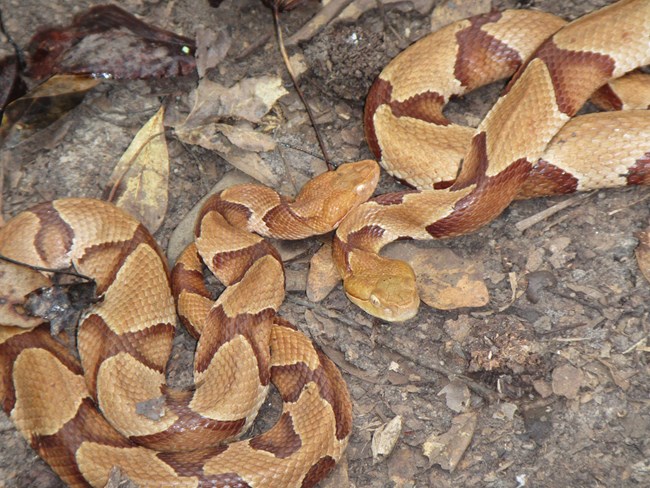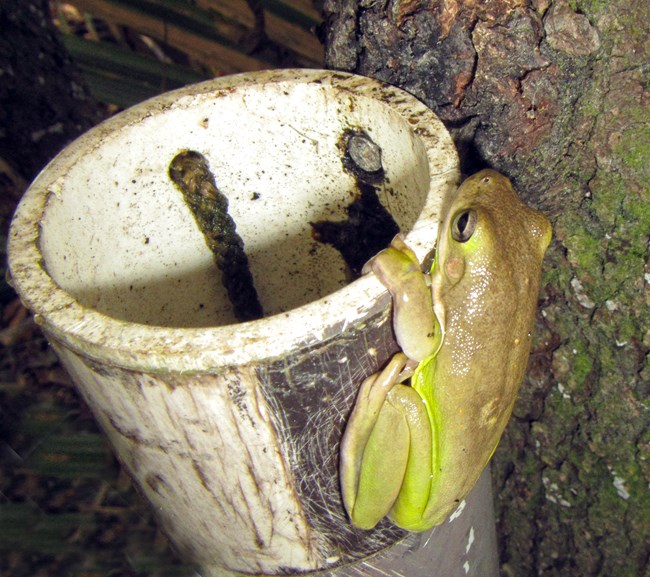
photo by Chris Adams
Overview
Jean Lafitte National Historical Park and Preserve, established in 1978, consists of six separate units in the Mississippi Delta region. Of these, only one, the Barataria Preserve, is included in the I&M program. The 8,000-hectare Barataria Preserve is located in the upper freshwater zone of the Barataria Basin, one of the most productive estuarine wetlands in North America. It contains a portion of an abandoned delta of the Mississippi River and associated ecological zones. Because the Mississippi River is now confined with levees and other alterations, the preserve's wetlands no longer receive sediment and fresh water during regular flood events. Restoration of natural hydrology is not feasible; however, the preserve gets some freshwater inputs from a large, controlled river diversion constructed by the U.S. Army Corps of Engineers. Alterations to the park's hydrology, both past and present, are a principle management concern for the park, as are erosion along lakes and other waterways, high local rates of subsidence, development around the park (introducing pollutants and non-native species), and the existence of human-made canals and spoil banks that interrupt sheetflow and allow salt-water intrusion.

Photo by Chris Adams
Ecosystems in the Barataria Preserve, Jean Lafitte NHP&P
The natural communities of the preserve are broadly determined by their underlying geological structure and hydrology. These communities range from
- Relatively upland hardwood forests;
- Several types of freshwater wetlands, forested and unforested, including bottomland forests, swamps, and marshes;
- Freshwater aquatic ecosystems, consisting of bayous, ponds, and estuarine lakes; and
- Furthest from land, there are areas of the marsh that mix with salt water, making intermediate, brackish or tidal marsh.
The most upland forest types are the natural levee forests and live-oak (Quercus virginiana) forests. These forests occur on and around the levees that flank an abandoned distributary channel of the Mississippi River, which forms the backbone of the preserve. The levees are ribbons of relatively firm alluvial soils; they are the preserve's only ground that is naturally above sea level.
Ridge and swale bottomland hardwood forests may also occupy levees or be directly adjacent to them. These forests can have a wide mix of tree species in the canopy, including Nutall's oak (Quercus texana), elms (Ulmus americana or crassifolia), sweetgum (Liquidambar styraciflua), sugarberry (Celtis laevigata) or water oak (Quercus nigra), as well as a dense understory of dwarf palmetto (Sabal minor).
On the backslopes of the levees, where the soils are inundated much of the year, there may be occasional transitional red-maple swamp forests, or more commonly, bald cypress (Taxodium distichum) and water tupelo (Nyssa sylvatica) swamps. Another plant community on the park’s flooded sections is the shrub swamp, with button bush (Cephalanthus occidentalis) as the dominant species there.
The preserve’s marshes occur beyond the swamps where alluvial soils have subsided well below sea level. Above this sunken surface lies a layer of peat, often many feet thick. The peat supports a unique type of floating marsh locally known as “flotant.” These freshwater marshes cover large areas of the preserve. Finally, there are several patches of brackish marsh, dominated by Spartina alterniflora and other salt-tolerant plant species, particularly in the southern-most section of the preserve.

Billy Finney/NPS
The forests and marshes of the park are home to diverse amphibians and reptiles, in addition to many other vertebrate and invertebrate species. There are several species of treefrogs, such as the bird-voiced treefrog (Hyla avivoca), squirrel treefrog (Hyla squirella) and green treefrog (Hyla cinerea). Other amphibians include the narrow-mouthed toad (Gastrophryne carolinensis), gulf coast toad (Incilius nebulifer) and the dwarf salamander (Eurycea quadridigitata). Reptiles include American alligators (Alligator mississipiensis), green anoles (Anolis carolinensis), skinks (Eumeces sp. or Scincella lateralis), and both venomous and non-venomous snakes, such as copperhead snakes (Agkistrodon contortrix), cottonmouth snakes (Agkistrodon piscivorus) and crayfish snakes (Regina rigida).

GULN/NPS

Billy Finney/NPS
Vital Signs Monitored at Jean Lafitte NHP&P
The Gulf Coast Network monitors four indicators of ecological health—called vital signs — at this park. They are:Source: NPS DataStore Saved Search 3717. To search for additional information, visit the NPS DataStore.

photo by Chris Adams
Last updated: November 10, 2023
